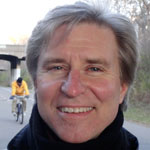Tim Springer owns properties in Phillips and Powderhorn neighborhoods. Since his undergraduate days at Colby College in Maine, he has been implementing energy efficient measures. In the mid-1980s, he was a board member for the Recycling Association of Minnesota and board president for the Minnesota Renewable Energy Society. Those efforts led him to UC-Berkeley, where he earned a Master’s in Energy and Resources. That was followed by a stint as a Waste Reduction consultant, and then co-founder and Executive Director of the Midtown Greenway Coalition.
He is a bicyclist who hasn’t owned a car since 1984. Perhaps symbolically, he owned for six months a VW bug before it had a gas leak, caught on fire, and burned up.
 Mikki Morrissette: What have you done to sustainably enhance your rental units?
Mikki Morrissette: What have you done to sustainably enhance your rental units?
Tim Springer: I own eight apartments in two fourplex buildings in the Powderhorn Neighborhood, and four houses in the Phillips Neighborhoods. I have efficient heating plants operating at the apartment buildings, even though the tenants pay for heat, and use CFLs in the common areas. I have had Home Energy Squad visits at all but one of my houses, and have added more attic insulation at two houses. I had solar (electric) evaluations done at one rental house and one apartment building. The apartment building turns out to be a great site, so someday…
The biggest changes are in my primary residence on the edge of the Midtown Greenway at 18th Avenue. I worked with contractors on a gut rehab in 1997 that increased the wall thickness, and put in all new windows and high-efficiency water heater and furnace appliances. We have clothes lines in the basement and the yard so we don’t use our dryer year-round. In fact, we didn’t have a dryer at all for a few years. Many Europeans don’t have dryers.
Our light fixtures that are not on dimmers have CFLs in them, and we challenge ourselves so as not to waste energy. For example, in the evening if I’m home alone it is not uncommon for there to be only two light bulbs burning, one on the front of the house and one in the room where I’m sitting.
My bucket list includes a goal of using no fossil fuels in my house. I plan to have photovoltaic panels put on my house this year to provide more juice than we use. In the future I hope to add high efficiency storm windows to my already efficient windows, insulate the foundation, add solar thermal panels on the south side of the house, and perhaps a pellet-burning stove with an auger to feed the pellets in automatically.
One obstacle that has kept me from exploring more significant improvements in my buildings is concern about adding rigid insulation in a way that would create a moisture barrier and rot the wood framing inside the walls. I’m sure it can be done properly, but monkeying with 100-year-old buildings needs to be done thoughtfully.If we actually get the array and manage to do it..the day I get to see it up will be a great day. We’ll get there. We had a public event with 50-some people in attendance. That was gratifying. This project is really one step at a time and you’re never sure it’s going to work out, but when it does, it’s pretty exciting. It’s certainly a slow process.
Mikki Morrissette: What sustainability myths do you wish other landlords were more aware of?
Tim Springer: In the U.S., more energy is used in buildings than in our transportation sector. Rental residential buildings make up a meaningful share of all buildings. If we are to make meaningful headway decreasing our collective carbon footprint, we can leave no stone un-turned.
As landlords, there is no excuse to delay no-cost and low-cost improvements, and to encourage and be role models for behavior changes, as well as get creative about more costly capital improvements.
My leases each have an addendum that requires tenants to participate in the City’s recycling program. I have begun adding an optional clause that suggests tenants consider being responsible global citizens by not wasting energy.
Mikki Morrissette: What inspires you on the green front?
Tim Springer: I am inspired by super-insulated houses that can almost be heated by body heat and a few light bulbs. There are now a handful of such houses in Minneapolis. In addition to a zero-net energy house, another item on my bucket list is to construct a zero-net energy eight-unit apartment or condo building. The economics don’t support it right now in the neighborhood where I own the land for it, but hopefully I’ll figure out how to make it happen when the time is right.
Click here to read the original interview from MPLSGreen.com >>
Mikki Morrissette is a long-time journalist, relocated from New York City publishing to her home state, and is founder of MPLSGreen.com.


